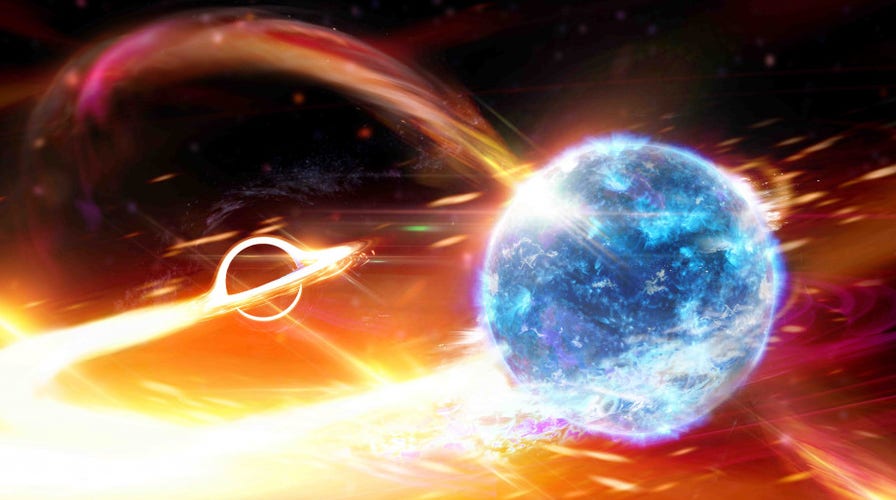Fox News Flash top headlines for August 19
Fox News Flash top headlines for August 19 are here. Check out what's clicking on Foxnews.com
A black hole swallowing a neutron star has likely been detected for the first time, according to scientists.
The Australian National University (ANU), which participated in the research, explains that the “cataclysmic event” was detected on Aug. 14, 2019, by gravitational-wave discovery machines in the U.S. and Italy. The machines detected ripples in space and time from an event that happened about 8,550 million trillion kilometers away from Earth, ANU said in a statement.
“Neutron stars and black holes are the super-dense remains of dead stars,” it explained, noting that scientists are still studying the data to work out the size of the two objects.
FIRST-EVER BLACK HOLE IMAGE REVEALED
"About 900 million years ago, this black hole ate a very dense star, known as a neutron star, like Pac-man -- possibly snuffing out the star instantly," said Professor Susan Scott, leader of the General Relativity Theory and Data Analysis Group at ANU and a chief investigator with the Australian Research Council's Centre of Excellence for Gravitational Wave Discovery (OzGrav), in the statement.

Artist's impression of a black hole about to swallow a neutron star. (Credit: Carl Knox, OzGrav ARC Centre of Excellence)
Initial findings suggest “a very strong likelihood” of a black hole devouring a neutron star, according to ANU. "Scientists have never detected a black hole smaller than five solar masses or a neutron star larger than about 2.5 times the mass of our Sun,” said Scott. "Based on this experience, we're very confident that we've just detected a black hole gobbling up a neutron star.”
However, Scott also acknowledged the slight possibility that the swallowed object was “a very light black hole.”
FIRST-EVER BLACK HOLE PICTURE PROVES THE POWER OF SCIENCE, SAYS FORMER NASA ASTRONAUT
The Advanced Laser Interferometer Gravitational-wave Observatory (LIGO), which is operated by Caltech and MIT, detected the event, as did its Virgo sister facility near Pisa, Italy.
LIGO uses identical detector sites in Washington State and Louisiana to operate as a single "observatory.” Virgo is located at the site of the European Gravitational Observatory (EGO).
In a separate project, scientists released the first-ever image of a black hole earlier this year, revealing the distant object in stunning detail.
BLACK HOLE AT MILKY WAY'S CENTER SEEN BEHAVING STRANGELY
The groundbreaking discovery was made by the Event Horizon Telescope, an international project involving telescopes across the globe that describes itself as a “virtual Earth-sized telescope.” Telescopes in Hawaii, Arizona, Chile, Mexico, Spain and the South Pole participated in the ambitious research project.
CLICK HERE TO GET THE FOX NEWS APP
The black hole was spotted in galaxy Messier 87 (M87), 55 million light-years away. A light-year, which measures distance in space, equals 6 trillion miles.
Follow James Rogers on Twitter @jamesjrogers

